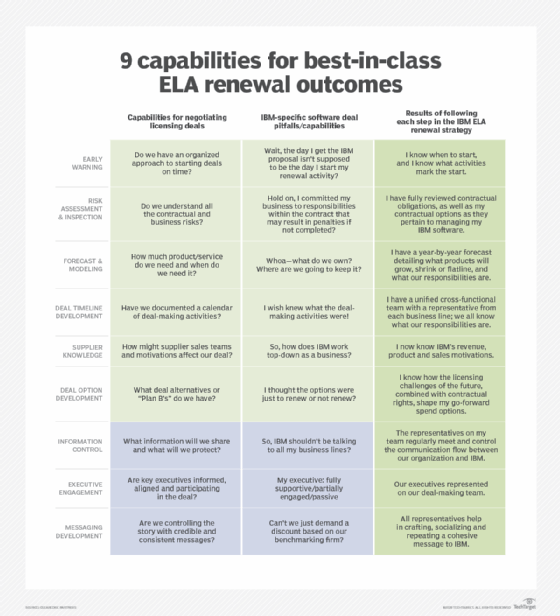Controlling IBM licensing agreement narrative key to success
Take control of the information narrative and unify your messaging strategy through a cross-functional negotiation team for best-in-class enterprise license agreement renewals.
"You do not get what you deserve. You get what you have the leverage to negotiate. So make sure you have [that] leverage before you're negotiating," said Eugene Cho of consultancy ClearEdge Partners, based in Needham, Mass. Cho, who runs ClearEdge's Transactional Software and IBM Practices, said this when discussing negotiation strategies for IBM licensing agreement renewals.
That discussion took place in a webinar, "Managing Leverage in an IBM Deal," where Cho applied ClearEdge's enterprise license agreement (ELA) strategy or "leverage management maturity model" to IBM-specific ELAs. The model consists of nine steps.
In part 1 of this article series, we addressed step 1, preparing for IBM ELA renewals by getting the process started early; step 4, developing a timeline and calendar; and step 6, understanding your options. Part 2 explained step 5, supplier knowledge, where you gain insight into your supplier (IBM in this case), its revenue model and motivations. Part 3 covered what many of Cho's clients consider the most complicated and difficult steps: 2, performing a risk assessment and inspection on your current IBM licensing agreement; and 4, forecasting and modeling future needs.
Effective communication within and without your organization is key for a successful IBM ELA renewal. Without it, all the other steps would exist in their own distinct information and process silos, making success that much more difficult. According to Cho, steps 7, information control; 8, executive support; and 9, messaging development, are crucial here. Tied closely together, they help you wrest control of the negotiation narrative from IBM.
Information control
ClearEdge often hears from clients that "IBM seems to have this uncanny ability to know exactly what you want to buy in what quantities by when," said Cho. "It's tough."
This can happen because, unlike software and services sold by vendors like Salesforce or Adobe, your IBM software licensing agreement reaches into multiple areas of your organization due to the extent and range of Big Blue's intellectual property, product portfolio and catalog. "It likely touches your IT team, who has to manage your mainframe, your security tools and your networking tools," noted Cho. There could also be DevOps licenses, he added, as well as collaboration tools used by business lines, marketing, logistics and the supply chain tools like IBM Sterling ecommerce, or planning tools for shipping and handling, accounting and finance.
Cho said IBM renewal success means getting all stakeholders from across the business with a "vested interest in some form of IBM technology" on the same page -- preferably by creating cross-functional negotiation teams. That way, he explained, IBM won't end up speaking with individual stakeholders before they've met internally to collect requirements and put together a negotiation strategy.
Cross-functional deal making teams = agile and nimble
ClearEdge clients tell the consultant firm they often have to look beyond their ELA negotiation team for accounting resources to book an agreement, locate financing resources to prove funds, understand whether or not a technology is truly needed or a "nice to have," or determine if there is a potential compliance risk, according to Eugene Cho, head of ClearEdge's Transactional Software and IBM Practices.
This complicates the IBM software subscription and ELA renewal, making the process more cumbersome and time-consuming -- thereby weakening your position at the deal-making table.
Assembling a cross-functional deal-making team with stakeholders from throughout your organization improves the chances of your IBM software licensing agreement negotiations tipping in your favor.
Cho said the cross-functional team should include:
- Dedicated accounting and financing resources for deal booking and budgeting;
- Dedicated IT leaders who manage the spending of each IT function;
- Dedicated asset management and governance/compliance teams to validate software asset management and prevent audits; and
- Unified procurement/sourcing/supply chain groups with a single version of truth and strategy.
Cho noted how agile and nimble are the key words everyone talks about when it comes to operating and managing their IT environment nowadays. Following the cross-functional team approach to IBM ELA renewals, he added, can bring that kind of agility and nimbleness to your software licensing agreement negotiations with Big Blue.
Executive engagement
The level of executive engagement with the IBM ELA renewal negotiations process may vary. But Cho said his clients who are most successful are those that have executive support.
Executives should, for example, direct IBM representatives to designated deal makers so there aren't multiple points of contact. They should also, preferably, fully endorse deal-making activity across the designated cross-functional team.
"It is very important that executives are empowering in lockstep with you folks," Cho said. "It doesn't really matter if it's a bottom-up or top-down exercise. What's key is that all of you are on the same page."
Even for those with executive support, the level of support can vary, however. "We hear a lot of clients say their executives are fully supportive but may sometimes be letting things slip," he said. "We also hear a lot of times [that] executives are kind of passive and let you own the reins."
The latter can sometimes benefit the IBM licensing agreement negotiation team, Cho noted. It can result in executives letting you control specific aspects of the negotiation process, such as information and messaging.
Messaging development
Messaging development simply means developing a unified communication approach when preparing for negotiations and -- just as importantly -- during the deal-making process itself. After all, "no one likes to be contradicted at the negotiation table by a vendor," let alone by other members of their own team during the renewal process, Cho said.
This kind of awkwardness happens when IBM has spoken to others in your organization without your knowledge, or because the cross-functional IBM software licensing agreement team itself hasn't developed a unified messaging strategy.
To prevent these kinds of problems, ask yourself two questions, Cho said: "Is everyone on the same page, looking in the same direction with what they say to the supplier [IBM]?" and "Can we back that story up?"

Gaining information control through the creation of a cross-functional negotiation team goes part and parcel with the messaging development and executive engagement steps (however involved executives actually are) of ClearEdge's IBM ELA negotiation strategy. Not only do steps 7 through 9 assure all relevant stakeholders are properly involved in the process, they engender a cohesive communication front where everyone on your team presents a consistent message interacting with IBM and the wider organization.
About ClearEdge Partners
Founded by senior sales executives from large IT suppliers and informed by current market analytics, ClearEdge enables CIOs and their teams to make more competitive IT investments. By combining rigorous inspection and IT financial expertise, they identify risk and opportunity, align internal teams and maintain leverage throughout the lifecycle of supplier relationships. As a result, their clients maximize the value of their investments by unlocking millions of dollars from legacy spending and redirecting funds toward IT modernization, digital and cloud transformation with confidence and speed.








